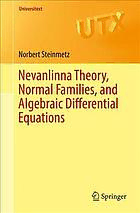
Nevanlinna theory, normal families, and algebraic differential equations PDF
Preview Nevanlinna theory, normal families, and algebraic differential equations
Universitext Norbert Steinmetz Nevanlinna Theory, Normal Families, and Algebraic Differential Equations Universitext Universitext Serieseditors SheldonAxler SanFranciscoStateUniversity CarlesCasacuberta UniversitatdeBarcelona AngusMacIntyre QueenMary,UniversityofLondon KennethRibet UniversityofCalifornia,Berkeley ClaudeSabbah Écolepolytechnique,CNRS,UniversitéParis-Saclay,Palaiseau EndreSüli UniversityofOxford WojborA.Woyczyn´ski CaseWesternReserveUniversity Universitext is a series of textbooksthat presents material from a wide variety of mathematicaldisciplinesatmaster’slevelandbeyond.Thebooks,oftenwellclass- testedbytheirauthor,mayhaveaninformal,personalevenexperimentalapproach to their subject matter. Some of the most successful and established books in the series have evolved through several editions, always following the evolution of teachingcurricula,toverypolishedtexts. Thus as research topics trickle down into graduate-level teaching, first textbooks writtenfornew,cutting-edgecoursesmaymaketheirwayintoUniversitext. Moreinformationaboutthisseriesathttp://www.springer.com/series/223 Norbert Steinmetz Nevanlinna Theory, Normal Families, and Algebraic Differential Equations 123 NorbertSteinmetz FakultaRtfuRrMathematik TUDortmund Dortmund Germany ISSN0172-5939 ISSN2191-6675 (electronic) Universitext ISBN978-3-319-59799-7 ISBN978-3-319-59800-0 (eBook) DOI10.1007/978-3-319-59800-0 LibraryofCongressControlNumber:2017942798 ©SpringerInternationalPublishingAG2017 Thisworkissubjecttocopyright.AllrightsarereservedbythePublisher,whetherthewholeorpartof thematerialisconcerned,specificallytherightsoftranslation,reprinting,reuseofillustrations,recitation, broadcasting,reproductiononmicrofilmsorinanyotherphysicalway,andtransmissionorinformation storageandretrieval,electronicadaptation,computersoftware,orbysimilarordissimilarmethodology nowknownorhereafterdeveloped. Theuseofgeneraldescriptivenames,registerednames,trademarks,servicemarks,etc.inthispublication doesnotimply,evenintheabsenceofaspecificstatement,thatsuchnamesareexemptfromtherelevant protectivelawsandregulationsandthereforefreeforgeneraluse. Thepublisher,theauthorsandtheeditorsaresafetoassumethattheadviceandinformationinthisbook arebelievedtobetrueandaccurateatthedateofpublication.Neitherthepublishernortheauthorsor theeditorsgiveawarranty,expressorimplied,withrespecttothematerialcontainedhereinorforany errorsoromissionsthatmayhavebeenmade.Thepublisherremainsneutralwithregardtojurisdictional claimsinpublishedmapsandinstitutionalaffiliations. Printedonacid-freepaper ThisSpringerimprintispublishedbySpringerNature TheregisteredcompanyisSpringerInternationalPublishingAG Theregisteredcompanyaddressis:Gewerbestrasse11,6330Cham,Switzerland Rolf Nevanlinna (1895–1980) Hans Wittich (1911–1984) Photo:Privatelyowned Introduction and Preface NevanlinnaTheory,NormalFamilies, andAlgebraicDifferentialEquations—how arethesetopicsrelatedtoeachother? Zalcman’s Re-scaling method set up a way to combine Nevanlinna Theory and Normal Families in both directions—to prove qualitative (‘soft’) results in Nevanlinna Theory by using Normal Family methods, and to prove normality criteriausingresultsfromNevanlinnaTheoryasapattern.PartofSchiff’sNormal Families is dedicated to this interesting and fruitful connection. In the present Chap.4, some old and new results in this direction are presented. Moreover, the connectionof NormalFamilieswith AlgebraicDifferentialEquationsisdiscussed onanelementarylevel. In his seminal paper on the value distribution of meromorphic functions and theirderivatives,HaymanopenedanewfieldofapplicationofNevanlinnaTheory. Some of his results on differential polynomials are outlined in his indispensable Meromorphicfunctions.He initiated a vast field of researchin the 1970sand 80s, which to the author’s knowledge has never appeared in book form. Nevanlinna himselfwasthefirsttoapplyhistheorytoproblemsofuniquenessofmeromorphic functions, known as the Five- and Four-Value Theorems. The enormous progress initiatedbyGunderseninthe1980sandearly90shasalsoneverbeenpresentedin bookform.IncombinationwithintroductoryapplicationstoAlgebraicDifferential Equations,thesetopicsconstituteChap.3. ThebenefitsofapplyingNevanlinnaTheorytothefieldofAlgebraicDifferential Equations were first recognised in the early 1930s, and then systematically since the 50s due to the pioneering work of Wittich. Apart from single chapters and a fewremarksinthebooks[15,84,85,96,202],justLaine’smonographNevanlinna Theory and Complex Differential Equations is dedicated to this field. Since the beginning of the new century much progress has been made in the context of PainlevéDifferentialEquations.1 Forthefirsttime,Re-scalingandNormalFamily 1WequotefromtheintroductiontoL.A.Rubel’sEntireandmeromorphicfunctions[146],where theauthorexpressedtheneedtohavemoreexamplesofinterestingmeromorphicfunctions.One vii viii IntroductionandPreface argumentswere used to gain new insight into the nature of the so-called Painlevé transcendents and solutions to other algebraic differential equations. Inspired by Zalcman’sRe-scaling Lemma and older ideasdue to Yosida, the so-called Yosida classesenteredthestagequitenaturally.ThismaterialispresentedinChaps.5and 6, and in parts also in Chap.4. The monograph[60] is concerned with Painlevé’s Equationsfrom the complexanalytic point of view, but was published ‘too early’ to incorporate the newest developments, methods, and results. This, of course, mayhappentoeverybook.Regrettably,thetheoryofDifferentialEquationsinthe ComplexDomainisnotcommonlyacceptedasagenuinepartofComplexAnalysis, thoughitiscompletelybasedoncomplexanalytictechniques.Chapters2,3,and4 urgentlydemonstrate that the theory of Algebraic DifferentialEquations provides indispensabletools,andtheirsolutionsoftenmarktherangeofvalidityofimportant resultsinNevanlinnaTheory. Chapter1isincludedfortheconvenienceofthereader.Itprovidesmaterialfrom classical Complex Analysis, which—apparently or seemingly—does not belong to the generally accepted background. This is particularly true for the topics of OrdinaryDifferentialEquationsandAsymptoticExpansions. InChap.2notonlytheclassicalNevanlinnaTheoryisoutlined,butalsoCartan’s Theory of Entire Curves and the Selberg–Valiron Theory of Algebroid Functions is briefly presented. This includes generalisations of the Second Main Theorem and various applications to problems in Complex Analysis which then become ‘elementary’, The text is not written redundancy-free. Some of the problems are dealt with at an earlystage using the methodsat hand,andare picked up later on whennew toolsareavailable.Severalexamplesandexercisesrequireextensivecomputations, whichinprinciplecanberealisedbyhand.Itis,however,muchmoreconvenientto usesomecomputeralgebrasystemlikeMAPLE.Non-expertsliketheauthorcanuse MAPLElikeaseparatesheetofpapertocarryoutauxiliarycomputations. The present text was written within the first 2 years of my ultimate sabbatical, buthasa longhistory.It developedfromresearch in NevanlinnaTheory,Analytic Differential Equations, and related subfields of Complex Analysis starting in the late 1970s, with a break in the 90s, which were occupied by other activities. The choiceofthematerialnaturallydependsonpersonalpreferences,experiences,and skills.Ratherthantoaimatcompletenessofthepresentation,Iintendedtoexplain themainideasandresultsexemplarily. I appreciatethesupportandcriticism byfriendsandcolleagues.Ofcourse,the responsibilityformistakesand misinterpretationsremainswith me.I also profited very much from the survey by A. Eremenko and J. Langley within the English translationofthemonographValueDistributionofMeromorphicFunctionsbyA.A. Gol’dberg and I.V. Ostrovskii, and, in particular, from helpful comments by the promisingsourceofsuchexamplesisthePainlevétranscendents.However,inspiteofagrowing literature on these functions, the unfortunate fact is that the “proofs” are incomplete and not rigorous[...]—andalsoinearlierandtheearliestpapers,onecouldadd. IntroductionandPreface ix referees.Itisthankstothemifthepresentversionhasbecomemorereader-friendly thantheversiontheycommentedon. Finally, I gratefully acknowledge the seminal impact the wonderful books Aufgaben und Lehrsätze aus der Analysis I und II (Problems and Theorems in AnalysisIandII)byG.PólyaandG.Szegöhadonmesincemytimeasastudent. Theyaccompaniedmeforlife.IwouldbepleasedifsomeoftheexercisesIposed in place of proofsand worked outexamplescame close to the spirit of Pólya and Szegö.Definitionsandtheoremsformtheskeletonofatheory,whileitisbroughtto lifebyapplications,examples,andexercisesonly. Dortmund,Germany NorbertSteinmetz Contents 1 SelectedTopicsinComplexAnalysis ...................................... 1 1.1 AlgebraicFunctions..................................................... 1 1.1.1 LocalBranches.................................................. 2 1.1.2 RegularandSingularPoints.................................... 2 1.1.3 TheNewtonPolygon........................................... 4 1.1.4 AlgebraicCurves ............................................... 5 1.2 NormalFamilies ........................................................ 6 1.2.1 SequencesofHolomorphicFunctions......................... 6 1.2.2 SequencesofMeromorphicFunctions......................... 6 1.2.3 NormalFamiliesofMeromorphicFunctions.................. 9 1.3 OrdinaryDifferentialEquations........................................ 9 1.3.1 HolomorphicFunctionsofSeveralVariables.................. 10 1.3.2 Cauchy’sExistenceTheorem .................................. 11 1.3.3 LinearDifferentialEquationsandSystems.................... 12 1.3.4 SomeAlgebraicAspects ....................................... 13 1.3.5 Cauchy’s‘calculdeslimites’................................... 14 1.3.6 TheComplexImplicitFunctionTheorem..................... 15 1.3.7 DependenceonParametersandInitialValues................. 16 1.3.8 AnalyticContinuation.......................................... 16 1.3.9 Painlevé’sTheorem............................................. 17 1.4 AsymptoticExpansions................................................. 19 1.4.1 AsymptoticSeries .............................................. 19 1.4.2 AsymptoticIntegrationofDifferentialEquations............. 20 1.4.3 AsymptoticIntegrationofAlgebraicDifferential Equations........................................................ 22 1.5 Miscellanea.............................................................. 24 1.5.1 EllipticFunctions............................................... 24 1.5.2 ThePhragmén–LindelöfPrinciple............................. 25 1.5.3 Wiman–ValironTheory......................................... 28 1.5.4 TheSchwarzianDerivative..................................... 30 xi
